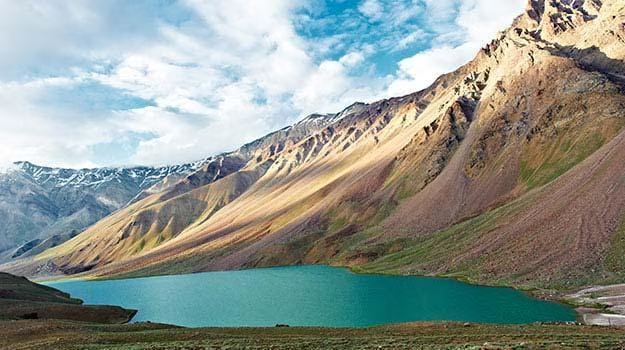Spiti – Pristine Lakes, World’s Highest Villages and Beautiful Cold Deserts
Journeying through Spiti is close to finding the real-world version of Shangri-La, courtesy of awe-inspiring landscapes. While you can't exactly catch a nap on the Dalai Lama's bed, which he uses during his visits, Spiti promises an experience that extends beyond tranquil monasteries and immaculate glaciers. The arrival of festivals in this region is marked by beautiful decorations, leading to joyful music and dancing year-round. If you find yourself in Spiti by late September, be sure to experience the triennial 'Chakhar Mela,' culminating in the Lamas' Chham dance. Boasting pristine lakes and some of the world's loftiest inhabited settlements, Spiti paints an unforgettable portrait of stark deserts and monasteries delicately clinging to the cliffs against a backdrop of azure skies. Its scant population and exceptional trekking trails give it an air of undiscovered seclusion, largely undisturbed by tourism. Situated at incredible heights and boasting a stunning landscape often likened to Ladakh prior to its tourist influx, Spiti makes an excellent road trip destination, with a potential bonus sighting of the elusive Snow Leopard.
Places to visit in Spiti - Hiking to Dhankar Lake
Embracing the clear azure skies, the ancient Dhankar monastery, crafted from mud and earth, is a spectacle to behold. Following a short interaction with the resident lamas, you embark on a rigorous uphill trek for about 3 kilometres. This challenging path through the desolate hills, with its rocky terrain strewn with loose pebbles over the sandy ground, offers astounding views of the snow-dusted peaks en route to Dhankar Lake. You might find a walking stick a useful companion on this near-vertical trail. Your journey is further enriched by the breathtaking sight of the confluence of the Spiti and Pin Rivers. Your reward is the crystalline waters of Dhankar Lake nestled amidst the stark mountainous landscape. From this vantage point, the towering Manerang peak, standing tall at 6700 meters, commands your attention.
Journey Through Pin Valley
Immerse yourself in the emerald expanse of Pin Valley, the verdant heart of Spiti, hemmed in by rugged landscapes and towering, uncharted mountains. As you navigate the slim rocky tracks leading to the valley's Shangri-La, you'll witness nature's awe-inspiring tapestry of lush pastures framed by snow-clad peaks and the infinite blue of the sky. Visualize the forests, waterfalls, and intoxicating fresh air. The landscape here is punctuated by charming hamlets that lie in the path of the winding Pin River, creating a tableau reminiscent of an exquisite picture postcard. The Pin Valley is a living museum of Tibetan culture, and it's home to the final remnants of the Buchen Lamas, belonging to the ancient Nyingmapa Sect of Buddhism. When you visit, don't miss the Kungri monastery in Sangam, where you can interact with these enigmatic lamas. Time your visit right, and you might get to see the 'Buchen lama dance,' a unique performance intended to purge village homes of evil spirits. Also worth exploring is Mudh, the valley's terminal village, where vibrant green fields, icy glaciers, and cascading waterfalls hold sway over the landscape. The Pin Valley, with its magnificent landscapes awash with captivating shades, promises to leave an indelible mark on your memory.
Explore Some of the World's Highest Villages
Begin your journey from Kaza, driving through stark mountains juxtaposed against vibrant blue skies, interspersed with verdant patches of farmland during the summer season. Your first destination is Langza, one of the loftiest inhabited villages globally. Langza is famed for its unbeatable location, offering some of the best views in Spiti and a treasure trove of untouched fossils scattered on its peripheries. The stunning view of Chau Chau Kang Nilda peak, rising 4400 meters above sea level with its solitary slopes, makes Langza a much-desired destination. If you stumble upon a fossil, pause and consider whether you should disturb this vestige of antiquity. Make sure to halt in Hikkim for a refreshing cup of tea with the postmaster of the world's highest post office. Send a few postcards before you continue to Komic, a village that seems to materialize out of nowhere. Known as the highest inhabited village in the Himalayas, Komic, with its small cluster of households, is a place where warm cups of tea and welcoming families await you. Perched at a dizzying altitude of 4587 meters above sea level, Komic provides mesmerizing views from its ancient monastery.
Discover Dhankar, Tabo, and Gue
As you enter Tabo, you'll be welcomed by the sight of prayer flags gently swaying in the breeze against a landscape of summer-green farmlands, stark mountains, and an azure blue sky. Over a millennium old, the Tabo Monastery, a UNESCO World Heritage site, stands as an exceptional example of Indo-Tibetan art. The monastery's unique architecture of robust mud walls and intricate murals are a sight to behold. Take a brief hike to the Tabo caves and immerse yourself in the tranquil aura that envelops these meditation grounds. Next, journey to the charming village of Gue. Here, amidst the fascinating tales that colour the Spiti landscape, you will encounter one legend in physical form – the 'Mummy of Gue.' This 500-year-old preserved body of a Tibetan lama is a sight that may evoke a sense of wonder and even eeriness. Look closely, and you may see the mummy's remaining strands of hair. It's a sight that demands seeing to be believed! Finally, visit Dhankar, a village that seems precariously balanced on a rugged cliff, and appears almost brittle from afar. As you approach, you'll begin to appreciate why such immense effort was invested in its construction over a thousand years ago. The breathtaking views of the confluence of the Spiti and Pin rivers and the valley beneath make Dhankar's mud-walled monastery a unique meditation spot. Don't miss the modest museum in the Gompa, and enjoy a chat with the resident lamas to learn more about the rich history and legends surrounding Dhankar Monastery.
Kye Monastery and Kibber
As you embark on your journey from Kaza to Kibber village, a hidden gem nestled on a rugged ridge overlooking the serene Spiti River, you'll come across a sight that captures the imagination - Kye Monastery. This enchanting monastery, the largest in the Spiti Valley, has stood tall since ancient times, tracing its roots back to nearly 1000 AD, making it the second oldest monastery after Tabo Monastery. With over 300 lamas residing within its walls, Kye Monastery exudes an air of tranquillity and spirituality that is enhanced by the soft glow of butter lamps, lit every evening. Step into this sacred space adorned with ancient murals and paintings, and you'll find yourself immersed in a world where time stands still. While photography is limited to the monastery's rooftop, be sure to capture a couple of breathtaking shots before entering. As you continue your journey, a warm welcome awaits you in Kibber village. Its quaint white houses, crowned with vibrant red rooftops, paint a picturesque scene against the backdrop of the majestic mountains. Situated at a lofty altitude of over 4200 meters above sea level, Kibberproudly holds the title of one of the highest inhabited villages in the Spiti Valley. Despite its remote location, Kibber thrives with life throughout the year, with its resilient inhabitants embracing both tourism and agriculture as means of sustenance. Experience the hospitality of the locals by opting for a homestay, and get a glimpse into their way of life. Don't miss the opportunity to take the ropeway, suspended over a deep gorge, from Kibber to Chicham village. This thrilling ride offers a unique perspective of the landscape, allowing you to appreciate the breathtaking beauty of the region. If you visit during the months of August and September, you'll be greeted by sprawling fields of peas, a testament to the fertility of Kibber's lands.
Chandrataal Lake Hike
Prepare yourself for an awe-inspiring adventure as you make your way to Chandrataal Lake, a natural wonder that beckons from the heights. Ascending to an impressive altitude of 4551 meters, the journey to Chandrataal Lake begins at Kunzum Pass, the primary gateway to the Spiti Valley from Lahaul. Brace yourself for a challenging yet rewarding drive along rocky roads that wind their way through the rugged terrain. After a little over three hours, you'll find yourself standing at the precipice of Kunzum Pass, ready to descend into a realm of surreal beauty. As you make your way down, the ethereal Chandrataal Lake reveals itself in all its glory. Aptly known as the "moon lake" due to its otherworldly charm, this magnificent body of water captivates visitors with its ever-changing hues of turquoise blue, reflecting the light of the morning sun. Legend has it that Chandrataal Lake holds a sacred place in history, as it is believed to be the site where Yudishtra, the eldest Pandava from the Mahabharata, ascended to heaven. Immerse yourself in the stories and folklore that surround this mystical place, allowing your imagination to roam freely in the tranquil surroundings. In the Spiti Valley, every step unveils a tapestry of ancient traditions, breathtaking landscapes, and untold tales. As you explore Kye Monastery, Kibber Village, and Chandrataal Lake, let the essence of this extraordinary land leave an indelible mark on your heart, forever preserving the magic of your journey.
Best time to visit Spiti
The enchanting Spiti Valley awaits your visit, and choosing the perfect time to embark on this adventure can make all the difference. For a delightful experience, plan your trip between late June and mid-September. During this period, the snow-bound passes open up, allowing for easier access, and the weather is pleasantly mild, with no need for heavy sweaters during the day. As you explore the picturesque villages of Kibber, Langza, and Komic, you'll be greeted by their vibrant charm, as the fields come alive in a beautiful shade of green. It's a time when Spiti Valley is at its best, offering you an opportunity to immerse yourself in its natural splendor. As the seasons change and autumn gives way to winter, Spiti Valley undergoes a transformation. By the end of October, snowfall becomes a regular occurrence, and the landscape is blanketed in a serene white. The winter months, however, bring forth harsh conditions, with abundant snowfall rendering most places inaccessible. While the Manali side becomes impassable, the road through Kinnaur remains open for the majority of the year, ensuring that Spiti is still reachable. Keep in mind that Chandrataal Lake, a majestic gem nestled in the valley, becomes inaccessible from both sides due to heavy snowfall blocking the high passes.
Things to carry
● To ensure a comfortable and enjoyable journey, it's essential to pack the right essentials. Don't fret about over-packing warm clothing; in Spiti, there's always the possibility of needing an extra layer, especially during chilly nights.
● Make sure to bring good, comfortable walking shoes, as well as a spare pair of sturdy hiking boots to tackle the rugged terrain.
● In winter, it's advisable to pack gloves, long johns, and a balaclava to keep you cosy. Additionally, a backpack and water bottle are essential companions for day trips, allowing you to stay hydrated and prepared.
● Considering the proximity to the sun, don't forget to pack sunscreen and sunglasses to protect yourself from the strong rays.
● Finally, a thoughtful gesture is to carry pens, sketch pens, or other stationery items to distribute among the children in the local villages, fostering connections and brightening their day.
With the right timing and a well-packed bag, you're ready to embark on an unforgettable journey through the mystical landscapes of Spiti Valley. Let the awe-inspiring beauty and warm hospitality of the region leave an everlasting impression on your heart.



Comments
Leave a reply